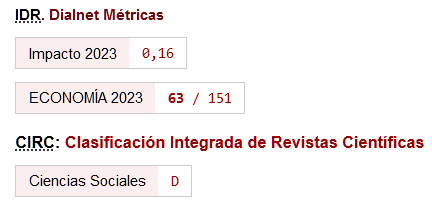Manifiesto del Observatorio de la Deuda (Debtwatch Manifesto)
Descargas
Citas
Adams, D. (1988). So Long, and Thanks for All the Fish.
Bean, C. (2010). "Joseph Schumpeter Lecture: The Great Moderation, the Great Panic, and the Great Contraction." Journal of the European Economic Association 8(2-3): 289-325.
https://doi.org/10.1111/j.1542-4774.2010.tb00505.x
Benati, L. (2008). "The 'Great Moderation' in the United Kingdom." Journal of Money, Credit, and Banking 40(1): 121-147. https://doi.org/10.1111/j.1538-4616.2008.00106.x
Bernanke, B. S. (2004). The Great Moderation: Remarks by Governor Ben S. Bernanke At the meetings of the Eastern Economic Association, Washington, DC February 20, 2004. Eastern Economic Association. Washington, DC, Federal Reserve Board.
Bernanke, B. S. (2004). Panel discussion: What Have We Learned Since October 1979? Conference on Reflections on Monetary Policy 25 Years after October 1979, St. Louis, Missouri, Federal Reserve Bank of St. Louis. https://doi.org/10.20955/r.87.277-292
Biggs, M. and T. Mayer (2010). "The Output Gap Conundrum." Intereconomics/Review of European Economic Policy 45(1): 11-16.
Biggs, M., T. Mayer, et al. (2010). "Credit and Economic Recovery: Demystifying Phoenix Miracles." SSRN eLibrary. https://doi.org/10.2139/ssrn.1595980
Blatt, J. M. (1983). Dynamic economic systems: a post-Keynesian approach. Armonk, N.Y, M.E. Sharpe.
Campbell, S. D. (2007). "Macroeconomic Volatility, Predictability, and Uncertainty in the Great Moderation: Evidence from the Survey of Professional Forecasters." Journal of Business and Economic Statistics 25(2): 191-200. https://doi.org/10.1198/073500106000000558
Canova, F. (2009). "What Explains the Great Moderation in the U.S.? A Structural Analysis." Journal of the European Economic Association 7(4): 697-721. https://doi.org/10.1162/JEEA.2009.7.4.697
D'Agostino, A. and K. Whelan (2008). "Federal Reserve Information during the Great Moderation." Journal of the European Economic Association 6(2-3): 609-620. https://doi.org/10.1162/JEEA.2008.6.2-3.609
Diamond, J. (2005). Collapse. How Societies Choose to Fail or Succeed. New York, Viking.
Fama, E. F. and K. R. French (1999). "The Corporate Cost of Capital and the Return on Corporate Investment." Journal of Finance 54(6): 1939-1967. https://doi.org/10.1111/0022-1082.00178
Fama, E. F. and K. R. French (2002). "Testing Trade-Off and Pecking Order Predictions about Dividends and Debt." Review of Financial Studies 15(1): 1-33. https://doi.org/10.1093/rfs/15.1.1
Fisher, I. (1933). "The Debt-Deflation Theory of Great Depressions." Econometrica 1(4): 337-357.
https://doi.org/10.2307/1907327
Fisher, I. (1936). 100% money. New York, Adelphi.
G.I. (2011). Serial Disappointment. The Economist. London, The Economist.
Galí, J. and L. Gambetti (2009). "On the Sources of the Great Moderation." American Economic Journal: Macroeconomics 1(1): 26-57. https://doi.org/10.1257/mac.1.1.26
Giannone, D., M. Lenza, et al. (2008). "Explaining the Great Moderation: It Is Not the Shocks." Journal of the European Economic Association 6(2-3): 621-633. https://doi.org/10.1162/JEEA.2008.6.2-3.621
Hicks, J. (1981). "IS-LM: An Explanation." Journal of Post Keynesian Economics 3(2): 139-154.
https://doi.org/10.1080/01603477.1980.11489209
Hicks, J. R. (1935). "Wages and Interest: The Dynamic Problem." The Economic Journal 45(179): 456-468. https://doi.org/10.2307/2224968
Hicks, J. R. (1937). "Mr. Keynes and the "Classics"; A Suggested Interpretation." Econometrica 5(2): 147-159. https://doi.org/10.2307/1907242
Hicks, J. R. (1939). Value and Capital: an inquiry into some fundamental principles of economic theory. Oxford, Oxford University Press.
Hudson, M. (2000). "The Mathematical Economics of Compound Interest: A 4,000-Year Overview." Journal of Economic Studies 27(4-5): 344-363. https://doi.org/10.1108/01443580010341853
Hudson, M. (2004). The Archaeology of Money: Debt versus Barter Theories of Money's Origins. Credit and state theories of money: The contributions of A. Mitchell Innes. L. R. Wray. Cheltenham, U.K, Edward Elgar: 99-127. https://doi.org/10.4337/9781843769842.00010
Keen, S. (1995). "Finance and Economic Breakdown: Modeling Minsky's 'Financial Instability Hypothesis'." Journal of Post Keynesian Economics 17(4): 607-635. https://doi.org/10.1080/01603477.1995.11490053
Keen, S. (1996). "The Chaos of Finance: The Chaotic and Marxian Foundations of Minsky's 'Financial Instability Hypothesis'." Economies et Societes 30(2-3): 55-82.
Keen, S. (1997). "From Stochastics to Complexity in Models of Economic Instability." Nonlinear Dynamics, Psychology, and Life Sciences 1(2): 151-172. https://doi.org/10.1023/A:1021882401004
Keen, S. (2000). The Nonlinear Economics of Debt Deflation. Commerce, complexity, and evolution: Topics in economics, finance, marketing, and management: Proceedings of the Twelfth International Symposium in Economic Theory and Econometrics. W. A. Barnett, C. Chiarella, S. Keen, R. Marks and H. Schnabl. New York, Cambridge University Press: 83-110.
https://doi.org/10.1017/CBO9780511896682.008
Keen, S. (2001). Debunking economics: The naked emperor of the social sciences. Annandale Sydney & London UK, Pluto Press Australia & Zed Books UK.
Keen, S. (2005). Expert Opinion, Permanent Mortgages vs Cooks. Sydney, Legal Aid NSW.
Keen, S. (2006). Steve Keen's Monthly Debt Report November 2006 "The Recession We Can't Avoid?". Steve Keen's Debtwatch. Sydney. 1: 21.
Keen, S. (2007). Deeper in Debt: Australia's addiction to borrowed money. Occasional Papers. Sydney, Centre for Policy Development.
Keen, S. (2008). Keynes's 'revolving fund of finance' and transactions in the circuit. Keynes and Macroeconomics after 70 Years. R. Wray and M. Forstater. Cheltenham, Edward Elgar: 259-278.
https://doi.org/10.4337/9781848446205.00027
Keen, S. (2010). "Solving the Paradox of Monetary Profits." Economics: The Open-Access, Open Assessment E-Journal 4(2010-31). https://doi.org/10.5018/economics-ejournal.ja.2010-31
Keen, S. (2011). Debunking economics: The naked emperor dethroned? London, Zed Books.
https://doi.org/10.5040/9781350250963
Keen, S. (2011). "Debunking Macroeconomics." Economic Analysis & Policy 41(3): 147-167.
https://doi.org/10.1016/S0313-5926(11)50030-X
Keen, S. (2011). "A monetary Minsky model of the Great Moderation and the Great Recession." Journal of Economic Behavior & Organization In Press, Corrected Proof.
Keynes, J. M. (1936). The general theory of employment, interest and money. London, Macmillan.
Keynes, J. M. (1937). "The General Theory of Employment." The Quarterly Journal of Economics 51(2): 209-223. https://doi.org/10.2307/1882087
Lucas, R. E., Jr. (1972). Econometric Testing of the Natural Rate Hypothesis. The Econometrics of Price Determination Conference, October 30-31 1970. O. Eckstein. Washington, D.C., Board of Governors of the Federal Reserve System and Social Science Research Council: 50-59.
Lucas, R. E., Jr. (2003). "Macroeconomic Priorities." American Economic Review 93(1): 1-14.
https://doi.org/10.1257/000282803321455133
Meadows, D. H., D. Meadows, et al. (2005). Limits to growth : the 30-year update. London, Earthscan.
Meadows, D. H., J. Randers, et al. (1972). The limits to growth. New York, Signet.
Minsky, H. P. (1957). "Monetary Systems and Accelerator Models." The American Economic Review 47(6): 860-883.
Minsky, H. P. (1982). Can "it" happen again? : essays on instability and finance. Armonk, N.Y., M.E. Sharpe. https://doi.org/10.1080/05775132.1982.11470774
Muth, J. F. (1961). "Rational Expectations and the Theory of Price Movements." Econometrica 29(3): 315-335. https://doi.org/10.2307/1909635
Obama, B. (2009). Obama's Remarks on the Economy. New York, New York Times.
Reinhart, C. M. and K. S. Rogoff (2008). This Time is Different: A Panoramic View of Eight Centuries of Financial Crises, National Bureau of Economic Research, Inc, NBER Working Papers: 13882.
https://doi.org/10.3386/w13882
Schumpeter, J. A. (1934). The theory of economic development : an inquiry into profits, capital, credit, interest and the business cycle. Cambridge, Massachusetts, Harvard University Press.
Shafer, W. and H. Sonnenschein (1993). Market demand and excess demand functions. Handbook of Mathematical Economics. K. J. Arrow and M. D. Intriligator, Elsevier. 2: 671-693.
https://doi.org/10.1016/S1573-4382(82)02009-8
Sonnenschein, H. (1973). "Do Walras' Identity and Continuity Characterize the Class of Community Excess Demand Functions?" Journal of Economic Theory 6(4): 345-354.
https://doi.org/10.1016/0022-0531(73)90066-5
Sraffa, P. (1960). Production of commodities by means of commodities :prelude to a critique of economic theory. Cambridge, Cambridge University Press.
Summers, P. M. (2005). "What Caused the Great Moderation? Some Cross-Country Evidence." Federal Reserve Bank of Kansas City Economic Review 90(3): 5-32.
Turner, G. M. (2008). "A comparison of The Limits to Growth with 30 years of reality." Global Environmental Change 18(3): 397-411. https://doi.org/10.1016/j.gloenvcha.2008.05.001
Turner, G. M., R. Hoffman, et al. (2011). "A tool for strategic biophysical assessment of a national economy - The Australian stocks and flows framework." Environmental Modelling & Software In Press, Corrected Proof. https://doi.org/10.1016/j.envsoft.2011.03.007
Woodford, M. (2009). "Convergence in Macroeconomics: Elements of the New Synthesis." American Economic Journal: Macroeconomics 1(1): 267-279. https://doi.org/10.1257/mac.1.1.267
Descargas
Publicado
Cómo citar
Número
Sección
Licencia
Esta licencia permite a terceros compartir (copiar y redistribuir el material en cualquier medio o formato) y adaptar (remezclar, transformar y crear a partir del material para cualquier finalidad, incluso comercial), siempre que se reconozca la autoría y la primera publicación en esta revista (La Revista, DOI de la obra), se proporcione un enlace a la licencia y se indique si se han realizado cambios en la obra.







